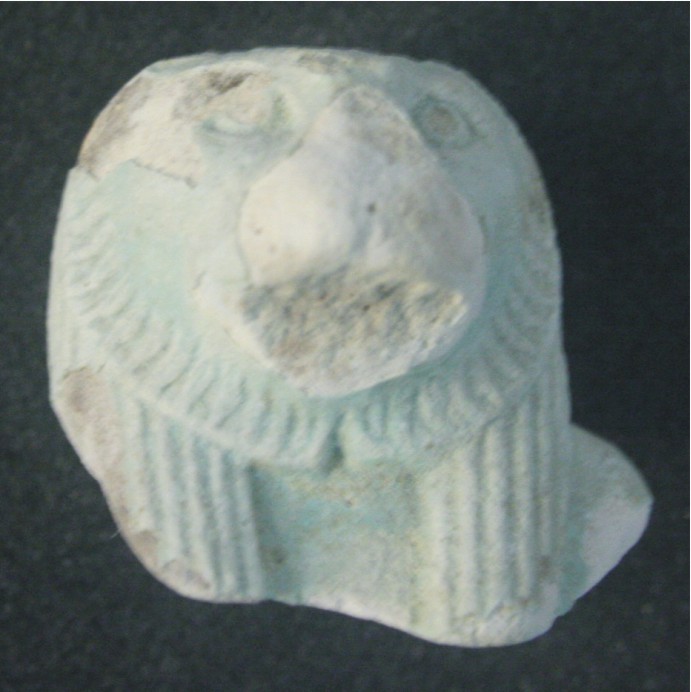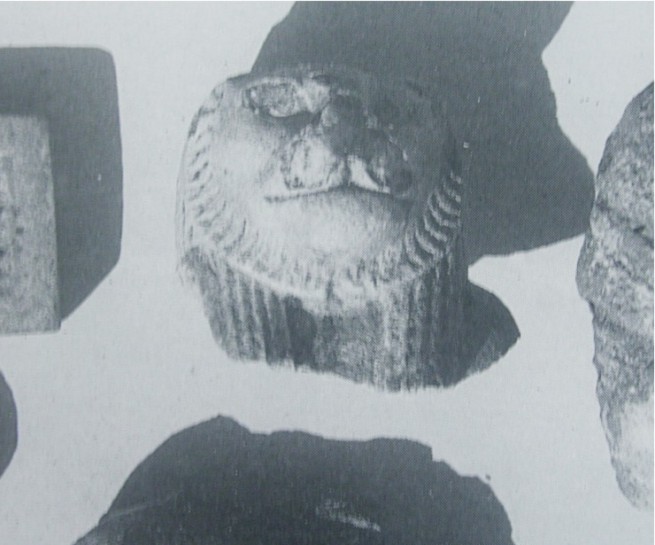EC451

Pen ffigwr o lew-dduw yn mesur 3cm o uchder. Mae twll yng nghopa pen yr arteffact, yn ôl pob tebyg i dderbyn penwisg. Mae olion rhif mewn inc ar waelod y darn ond mae wedi cael gormod o niwed i ni fedru’i ddarllen.
Mae darn tebyg iawn yn cael ei ddisgrifio fel un wedi dod o dŷ ym Meroe (Gweler Török 1997, Cyfrol 1, 205 a Chyfrol. 2 pl. 168; isod). Mae’r eitem yng nghyfrol Török wedi’i darlunio o ffotograff yn Garstang ac mae mor debyg i EC451 fel y credir mai’r un eitem ydynt. Llawer o ddiolch i Amgueddfa Archeolegol Garstang, Prifysgol Lerpwl am ganiatâd i ddefnyddio’r ffotograff. Fodd bynnag, mae EC451, o’i gymharu â’r ffotograff gwreiddiol, yn llawer mwy treuliedig ac mae’n dal yn bosibl credu fod yna ddwy eitem wahanol.
Mae’r mwyafrif o’r eitemau o adran hon y gyfrol am y tŷ ym Meroe yn ymddangos fel dodrefn teml neu gerfluniau o dduwiau neu addurniadau personol. Mae Török 1997, 1.205) yn disgrifio’r darn fel un, o bosib, o’r cyfnod Napatan Cynnar, sy’n ei ddyddio i 450-250CC.
Y prif lew-dduw ym Meroe oedd Apedmek, ffurf o Amun efallai. Ymddengys yn debygol mai ef yw’r duw a gynrychiolir gan y pen faience hwn.
Felly, mae’n debyg i EC451 gael ei chloddi gan Garstang yn ystod ei gloddiadau 1909-1914. Cyn belled ag y gellir gwirio, daeth yr eitem i Brifysgol Abertawe yn 1971 ynghyd â gweddill eitemau Wellcome sydd yn awr yn gnewyllyn y Ganolfan Eifftaidd, casgliad Abertawe. Fod bynnag, nid yw’n glir sut y cafodd Syr Henry Wellcome yr eitem. Rhoddwyd gwahanol arteffactau i danysgrifwyr y cloddiad. Mae gan y Ganolfan Eifftaidd lond dwrn o arteffactau eraill o Meroe sydd hefyd o gloddiadau Garstang. O leiaf prynwyd rhai o’r rhain gan Syr Henry Wellcome o gasgliad MacGregor y gwerthwyd rhan ohono yn 1922 (Sotheby 1922, lot 1321). Mae’n bosibl mai un o’r rheiny yw’r eitem hon, er nad yw’n cael ei disgrifio’n benodol yn y catalog. Gall, felly, naill ai fod wedi ei rhoi i Wellcome am danysgrifio cloddiadau Meroe, neu wedi ei phrynu o gasgliad arall.
Cyfeiriadau
Sotheby, Wilkinson and Hodge. 1922. Catalogue of the MacGregor Collection of Egyptian Antiquities, London.
Török, L. 1997. Meroe City. An Ancient African Capital. John Garstang’s Excavations in the Sudan. London: Egypt Exploration Society.
A very similar, piece is described as coming from a room of a house in Meroe (See Török 1997, Vol 1, 205 and Vol. 2 pl. 168; below). The item in the Török volume is illustrated from a Garstang photograph and is so similar to EC451 that it is assumed that EC451 is the same item. Many thanks to the Garstang Museum of Archaeology, University of Liverpool for permission to use this photograph. However, EC451 is much worn compared to the original photograph and there thus remains a slight possibility that the two are different items.

Most of the items from this area of the house in the Meroe volume appear to be temple furniture or statues of divinities and personal ornaments. Török (1997, 1.205) describes the piece as probably Early Napatan, which dates it to 450-250BC.
The chief lion deity at Meroe was Apedmek, perhaps a form of Amun. It seems likely that this is the deity represented by this faience head.
EC451 was thus probably excavated by Garstang during his 1909-1914 excavations. As far as can be ascertained, the item came to Swansea University in 1971 along with the rest of the Wellcome items which now make up the core of the Egypt Centre, Swansea collection. However, it is not clear how the item was obtained by Sir Henry Wellcome. Various artefacts were given to subscribers to the excavation. The Egypt Centre has a handful of other artefacts from Meroe which are also from Garstang’s excavations. At least some of these were purchased by Sir Henry Wellcome from the MacGregor collection, part of which was sold in 1922 (Sotheby 1922, lot 1321). It is possible that this constitutes one of those items, though the item is not specifically described in the catalogue. It may, therefore, alternatively have either been given to Wellcome for subscription to the Meroe excavations, or may have been purchased from another collection.
References
Sotheby, Wilkinson and Hodge. 1922. Catalogue of the MacGregor Collection of Egyptian Antiquities, London.
Török, L. 1997. Meroe City. An Ancient African Capital. John Garstang’s Excavations in the Sudan. London: Egypt Exploration Society.